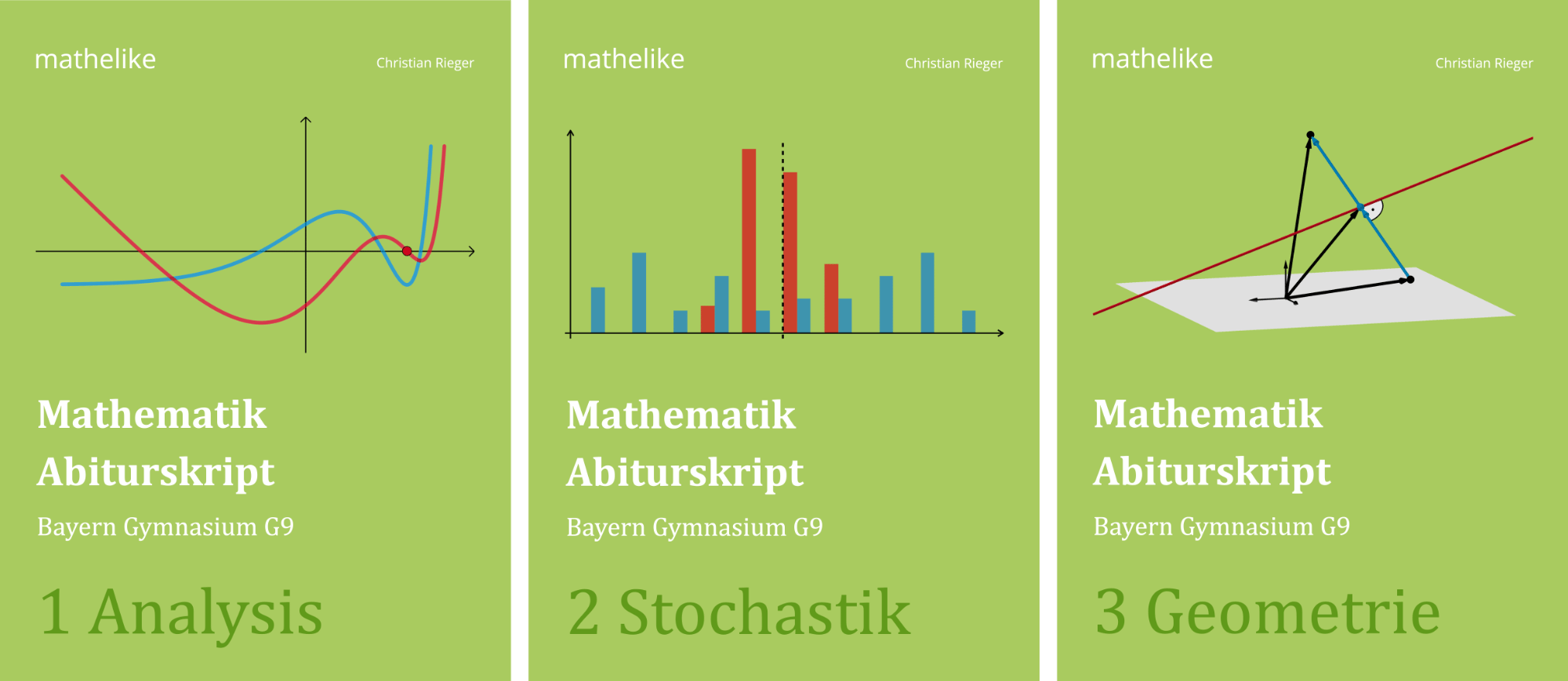Die Seitenfläche \(BCS\) der Pyramide liegt in der Ebene \(E\).
Betrachtet werden die Vektoren \(\overrightarrow{n}\), deren Koordinaten nicht alle gleich null sind. Begründen Sie, dass folgende Aussage richtig ist:
Gilt für einen solchen Vektor \(\overrightarrow{n} \circ \begin{pmatrix} -1\\2\\0 \end{pmatrix}= 0\) und \(\overrightarrow{n} \circ \begin{pmatrix} -1\\-1\\3 \end{pmatrix} = 0\), so ist er ein Normalenvektor von \(E\).
(3 BE)
Lösung zu Teilaufgabe b
\[\overrightarrow{BC} = \overrightarrow{C} - \overrightarrow{B} = \begin{pmatrix} 0\\6\\0 \end{pmatrix} - \begin{pmatrix} 2\\2\\0 \end{pmatrix} = \begin{pmatrix} -2\\4\\0 \end{pmatrix} = 2 \cdot \begin{pmatrix} -1\\2\\0 \end{pmatrix}\]
\[\overrightarrow{BS} = \overrightarrow{S} - \overrightarrow{B} = \begin{pmatrix} 0\\0\\6 \end{pmatrix} - \begin{pmatrix} 2\\2\\0 \end{pmatrix} = \begin{pmatrix} -2\\-2\\6 \end{pmatrix} = 2 \cdot \begin{pmatrix} -1\\-1\\3 \end{pmatrix}\]
Die Vektoren \(\overrightarrow{BC}\) und \(\begin{pmatrix} -1\\2\\0 \end{pmatrix}\) sowie \(\overrightarrow{BS}\) und \(\begin{pmatrix} -1\\-1\\3 \end{pmatrix}\) sind linear abhängig. Folglich ist \(\overrightarrow{n}\) senkrecht zu \(\overrightarrow{BC}\) und \(\overrightarrow{BS}\). Da die Vektoren \(\overrightarrow{BC}\) und \(\overrightarrow{BS}\) die Ebene \(E\) aufspannen, ist \(\overrightarrow{n}\) ein Normalenvektor der Ebene \(E\).
Ergänzende Erklärung (nicht verlangt)
Die Gleichungen \(\overrightarrow{n} \circ \begin{pmatrix} -1\\2\\0 \end{pmatrix}= 0\) und \(\overrightarrow{n} \circ \begin{pmatrix} -1\\-1\\3 \end{pmatrix} = 0\) bedeuten, dass \(\overrightarrow{n}\) senkrecht zu \(\begin{pmatrix} -1\\2\\0 \end{pmatrix}\) und \(\begin{pmatrix} -1\\-1\\3 \end{pmatrix}\) ist.
Anwendung des Skalarprodukts
Zueinander senkrechte (orthogonale) Vektoren
Zwei vom Nullvektor verschiedene Vektoren \(\overrightarrow{a}\) und \(\overrightarrow{b}\) sind genau dann zueinander senkrecht (orthogonal), wenn deren Skalarprodukt null ist.
\[\textcolor{#cc071e}{\overrightarrow{a}} \circ \textcolor{#0087c1}{\overrightarrow{b}} = 0 \; \Leftrightarrow \; \textcolor{#cc071e}{\overrightarrow{a}} \perp \textcolor{#0087c1}{\overrightarrow{b}}\]
Nun weiß man, dass \(\overrightarrow{n}\) ein Normalenvektor der Ebene \(E\) ist, da die in der Angabe formulierte Aussage richtig ist. Also müssen die Vektoren \(\textcolor{#cc071e}{\begin{pmatrix} -1\\2\\0 \end{pmatrix}}\) und \(\textcolor{#0087c1}{\begin{pmatrix} -1\\-1\\3 \end{pmatrix}}\) die Ebenen \(E\) aufspannen.
Andererseits spannen je zwei Verbindungsvektoren der Punkte \(B(2|2|0)\), \(C(0|6|0)\) und \(S(0|0|6)\) die Ebene \(E\) auf, denn die Seitenfläche \(BCS\) liegt in der Ebene \(E\) (vgl. Angabe).
Es ergibt sich:
\[\overrightarrow{BC} = \overrightarrow{C} - \overrightarrow{B} = \begin{pmatrix} 0\\6\\0 \end{pmatrix} - \begin{pmatrix} 2\\2\\0 \end{pmatrix} = \begin{pmatrix} -2\\4\\0 \end{pmatrix} = 2 \cdot \textcolor{#cc071e}{\begin{pmatrix} -1\\2\\0 \end{pmatrix}}\]
und
\[\overrightarrow{BS} = \overrightarrow{S} - \overrightarrow{B} = \begin{pmatrix} 0\\0\\6 \end{pmatrix} - \begin{pmatrix} 2\\2\\0 \end{pmatrix} = \begin{pmatrix} -2\\-2\\6 \end{pmatrix} = 2 \cdot \textcolor{#0087c1}{\begin{pmatrix} -1\\-1\\3 \end{pmatrix}}\]
Somit sind die Vektoren \(\overrightarrow{BC}\) und \(\textcolor{#cc071e}{\begin{pmatrix} -1\\2\\0 \end{pmatrix}}\) sowie \(\overrightarrow{BS}\) und \(\textcolor{#0087c1}{\begin{pmatrix} -1\\-1\\3 \end{pmatrix}}\) linear abhängig. Also ist \(\overrightarrow{n}\) senkrecht zu \(\overrightarrow{BC}\) und \(\overrightarrow{BS}\) und deshalb ein Normalenvektor der Ebene \(E\).



